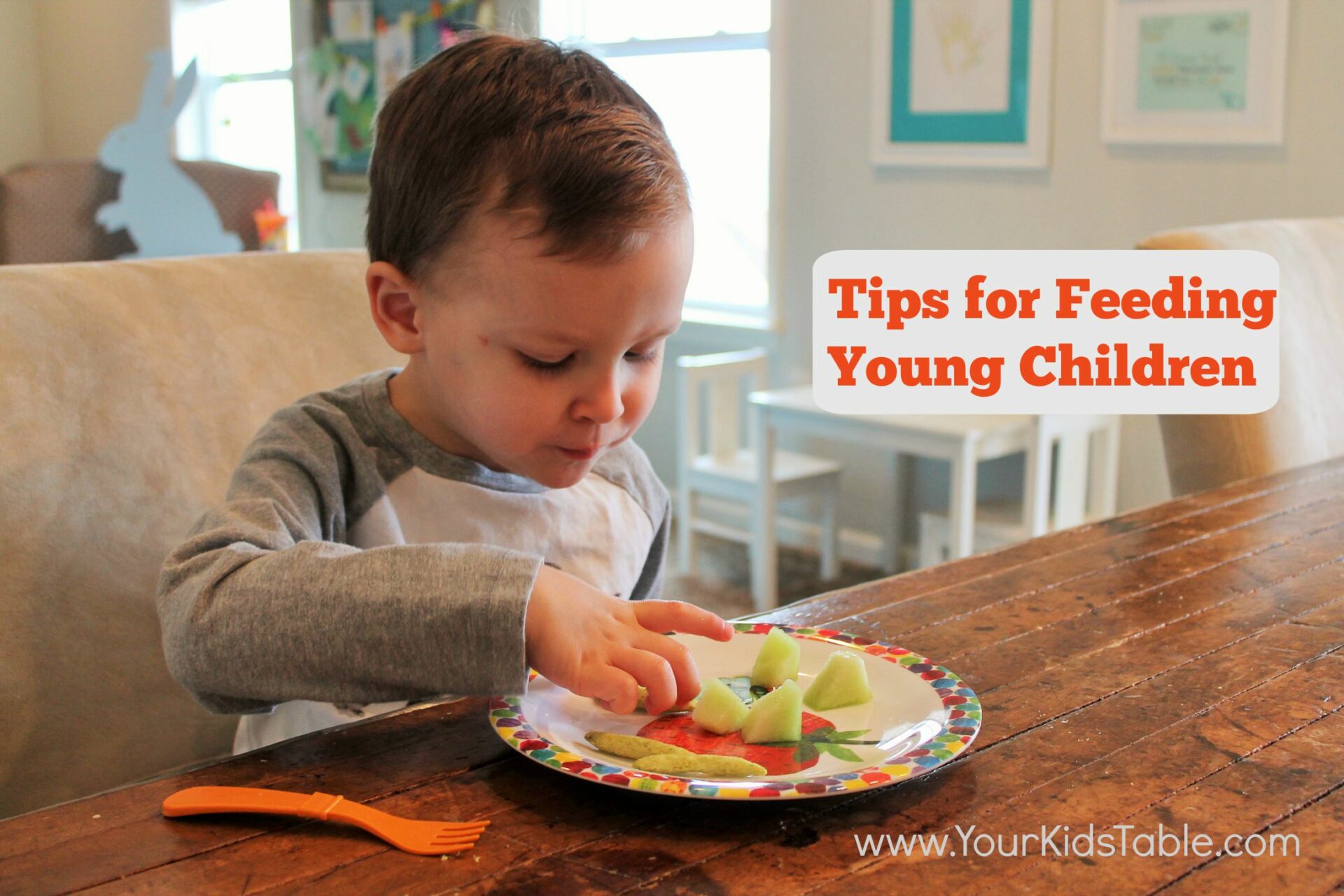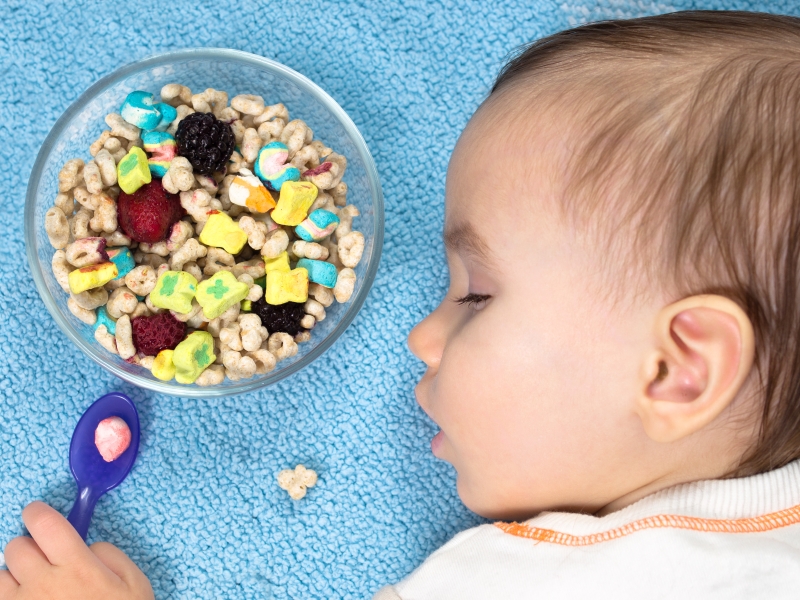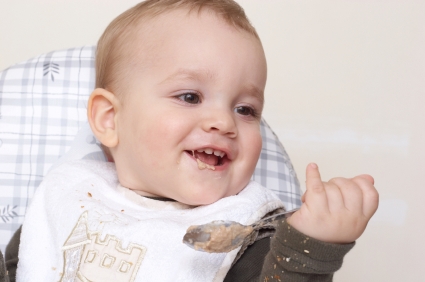Feeding Young Children
Thank you to Alisha Grogan, MOT OTR/L and creator of Your Kid’s Table for writing this guest post today. Alisha provides us with some extremely effective tips for feeding young children that will help to eliminate the stress around mealtimes, while encouraging good eating habits. Be sure to explore the rest of her website for valuable tips, meal suggestions, help with picky eating and more!
You’ve probably heard the expression, “Kid’s don’t come with a manual”, which implies parents have to determine the best way to proceed in teaching and disciplining children. While I fully support a parent’s intuition and instincts, there are a few areas parent’s often would like some guidance on, one of which is feeding young children. For some families, feeding their children can be very difficult and stressful if a picky eater or problem feeder is involved. While those situations can be quite difficult, they can be helped a lot by implementing some mealtime guidelines, or even avoided all together if they are put in place with babies and toddlers. No matter what the situation is in your home, these tips will help you and your child enjoy meals and experiment with new or non-preferred foods.
Set up a Schedule
Spacing meals apart is critical to your child being a good eater, I really can’t stress how important it is. In a way that makes sense for your family, you will want to create a schedule that starts with your child eating approximately 30 minutes after waking. Then, 2.5-3 hours later, have your next meal. Depending on your individual circumstances and preferences, this may be snack or lunch. By counting from the start of one meal to the start of the next, continue this same time interval throughout the day until bed. This usually results in three main meals and 1-2 snacks. Allow nothing but water in between these times, serving milk or juice as part of the meal. This will optimize your child’s appetite and create a desire to eat when it is meal time.
Keep the High Chair
I know the big high chairs can be cumbersome in kitchens and the trays are annoying to keep cleaning, but these seats and their ability to confine, ahem, I mean keep your child safe, are the best bet for a while. Babies have learned to associate eating with this chair and toddlers are notoriously distracted. If you try to have them eat at their own little table or at a big table before the age of 2.5, you are most likely going to be in a constant struggle just to keep them sitting at the table and their eating habits will surely suffer. There is nothing wrong with feeding young children in a high chair or booster seat with a strap until they are 3 or beyond. If you never stray from this, they won’t ever know the difference, sitting in a high chair or booster is all they have ever know. Once you let them kneel on a big chair or don’t strap them into the booster, it could be very difficult to return to the original set up.
Once you do move to strap-free eating situation, lay the ground rules quickly about staying seated. If you child insists on getting down, meal time is over for them. Make sure they understand this and follow through.
Avoid Constant Snacking
It has become quite commonplace to feed kids snacks throughout the day. We hand them crackers or cookies in grocery stores, doctors offices, cars, parties, and even church to keep them quiet. It doesn’t always stop there. In the beginning it can be hard to find a schedule for eating that works and leaving food out all the time can seem logical, or meal times become stressful and schedules are abandoned because it seems easier. It may be easier in the short term, but in the long run it will become more difficult to get good eating habits established. When kids are given snacks endlessly, the message sent is that we don’t need to sit and eat together (yes, even if it is just a snack) and that we can eat whenever we want. I think it is important to teach kids to respect meal time so they can develop healthy eating habits for life. Constant snacking totally defeats this, and snacking will likely sabotage the next meal because they don’t have an appetite.
In my day job as an occupational therapist, I see huge changes in a child’s eating when the family moves to structured, spaced out meals. At home, I also see a dramatic difference in my kid’s eating when they have snacked too frequently.
Forget the Toys
No toys, phones, tablets, or computers at the table might seem obvious to some of you, especially parents with babies that aren’t really trying to pull this stunt yet. I assure you there will be a day when your toddler is insistent and will ultimately throw a tantrum just to have the truck or doll at the table with them. In the moment, it is very easy to give in because you are exhausted and don’t have the battle in you. However, this is a battle worth fighting, even though that toy or tablet may be keeping them in their chair it will mostly distract them from actually eating. Sometimes it helps to place the toy in a spot where a child can see it (sometimes that makes it worse!). Either way, once your kiddo knows that you mean business about no toys coming to the table, they will stop trying.
*If your child is receiving feeding therapy, some therapeutic strategies employ the use of toys at meals.
Eat Together
Eat with your kids, often when babies start out on baby food they are on their own schedule and we focus just on feeding them at their own meal time. This should be short lived, if ever a scenario at all. If possible, it is a great habit and benefit to the baby to eat meals together. As they start to eat multiple times a day and begin table foods, try to find a way to have your eating schedules coincide. Serving your kids solo means them missing out on a variety of social interactions, as well as the powerful tool of modeling. Our children want to emulate us, for better or worse, and while we all know that they observe everything that we are doing, we often forget to apply that to eating. They notice that the broccoli is on our plate and what we like to eat. Not to oversimplify, but If your kid never sees you eating the broccoli, they might not eat it either.
Alisha Grogan, MOT OTR/L is the creator of Your Kid’s Table and a mom to three young boys. She is a pediatric occupational therapist that specializes in feeding difficulties such as picky eating/problem feeding and difficulty transitioning to table foods. She works in her Pittsburgh community and offers private consultations via skype, phone, and email to parents both nationally and internationally. You can also find her on Facebook, Twitter, and Pinterest.









